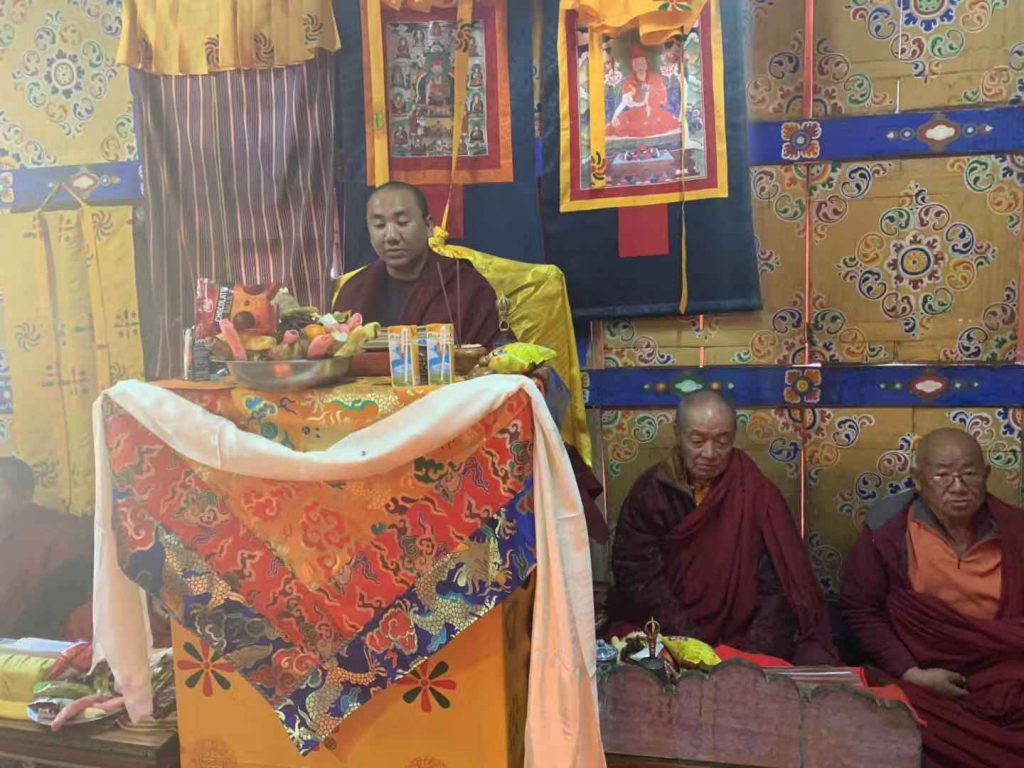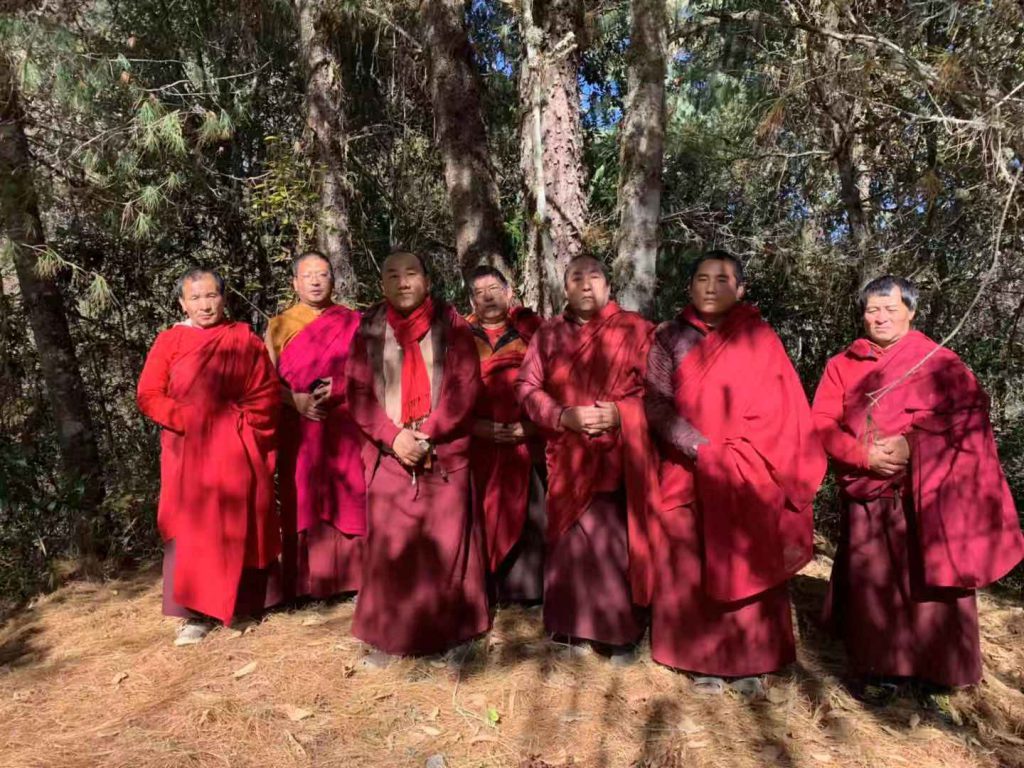Tulku Jamyang Tenzin Namgyel was born on the 8th auspicious day of the 3rd month of the Bhutanese Iron Horse year, which corresponds to the year 1990 in an area known as Chögyoe Mey Monastery. It is located near the Chi-Nyel Monastery in Metsho Gewog1 under Lhuentse District in eastern Bhutan. His father is Yeshey Gyeltshen and mother is Karma Dechen, a daughter of Lama Yeshey who was a close disciple of Tobden Yeshey Nyingpo.
There was an auspicious sign after his birth. A peach tree near his birthplace that previously used to blossom only in the 2nd month, miraculously started blossoming instead, in the 11th month annually. Lama Pema Long-Yang told Leki, a disciple of Tulku’s predecessor that Tulku was the body reincarnation of Lama Pema Chewang.
While venerable Khenpo Karpo, a close disciple of Kyabje Dudjom Rinpoche, was at Mukpa Khar Monastery to make offerings, Khenpo visited Tulku’s parent upon their request. As Tulku was always sick, his parent requested Khenpo to perform Kago2 so that he is cured. While Khenpo was performing Kago, Tulku hold Khenpo’s Phurba3 at which venerable Khenpo was pleased. Khenpo happily named Tulku as Kunzang Tenpai Nima with love and affection without anyone’s request.
1 zGewog is an administrative unit below the district or simply sub-district.
2 kago in simplistic view means giving a threatening command to the spirits by an enlightened lama to stop causing harm to a particular person.
3 Phurba is a ritual dagger with a pointed three-edge blade.
At an early age, Tulku could easily make recollections, a sign of being a body reincarnation of Lama Pema Chewang. Tulku used to ask time and again to bring his predecessor’s treasure, a terma statue and Tsemo, a female mule. At the age of two, Tulku met Lama Pema Long-Yang at Chögyam, his predecessor’s seat who was from Kham. Lama Pema Long-Yang tested Tulku for three nights and then recognized and enthroned him as the body reincarnation of Lama Pema Chewang. Since then, Tulku’s illness began curing gradually. On an auspicious day, venerable Lama Pema Long-Yang initiated Tulku’s first education on writing alphabets and reading Diamond Cutter Sutra.
One day, Her Majesty Ashi4 Sonam Choden Wangchuck arrived at Chögyam on a visit and she questioned Tulku whether the statue, Gyalings, 5 etc., belonged to him whereupon Tulku’s responded that the statue was not his but old Gyalings were. Venerable Lama Pema Long-Yang had endorsed the fact that those Gyalings, indeed, belonged to Tulku’s predecessor.
4 Ashi is a Bhutanese title of respect that is prefixed to the given name, and is female members of the Bhutanese royal family and female Bhutanese nobility.
5 Gyaling or Shawm is a traditional woodwind instrument used primarily in Tibetan Buddhist monasteries during chantings and prayers. Resembling an oboe, it is a double reed instrument and it requires a circular breathing technique to play, which brings forth a linear sound, even while the musician inhales.
While Kyabje Bairo Rinpoche was at Chögyam, Tulku used to make regular visits and meet Rinpoche who also recognized him as the true reincarnation of Lama Pema Chewang. Later, Rinpoche issued a certificate recognizing Tulku as reincarnation.
While Kyabje Bairo Rinpoche was giving a weeklong empowerment and transmission at Nimalung in Bumthang, Tulku and his parent along with Lama Pema Long-Yang’s body reincarnation went to receive an empowerment, according to the command of Lama Pema Long-Yang. After its conclusion, when Rinpoche was leaving for India, Tulku wept requesting that he be permitted to go with Rinpoche. Rinpoche and his spiritual consort told Tulku that someone needed to take care of him because he is young and since they needed to travel from one place to another most of the time, there would be no one to look after him.
In…, late Kyabje Dilgo Khyentse Rinpoche’s body was being moved to Kurje, Bumthang in central Bhutan. At that time, when Ani Sonam, the spiritual consort of Tulku’s predecessor clarified with Kyabje Thrulshig Rinpoche whether Tulku was a real reincarnation. Kyabje Thrulshig Rinpoche said thus, “don’t have doubts in your mind. He is a real reincarnation. Take care and keep him clean.” When Ani Sonam inquired whether Kurtoe in Lhuentse or Bumthang would be more auspicious, Kyabje Thrulshig Rinpoche replied that though both places are good, Bumthang was better. However, owing to their ignorance, they did not obtain a certificate of recognition.
In…, when late Kyabje Dilgo Khyentse Rinpoche’s body was in Paro in western Bhutan, Kyabje Mindroling Thrichen was present there. At the telephonic instruction of Ani Sonam who was in Bumthang, the adopted daughter of Tulku’s predecessor Sangye and her husband Lopen Chökyi inquired from Kyabje Mindroling Thrichen whether Tulku was a real reincarnation. At that moment, Kyabje Mindroling Thrichen was silent. However, the next day morning, Kyabje Mindroling Thrichen indeed issued to Sangye and Chökyi a certificate of recognition as genuine reincarnation. Ani Sonam had received the certificate. Lama Pema Long-Yang’s body reincarnation Lopen Drendu and Tsampa Pema Zigthar had conveyed to Tulku’s parent that the certificate had been received from Kyabje Mindroling Thrichen. However, Ani Sonam kept the certificate with her without giving it to Tulku’s parent saying that they would not be able to take care and would be handed over later once Tulku came of age. Some years later, Ani Sonam had died. Though searched, the certificate was untraceable and lost.
In…, Lama Pema Long-Yang had sought the permission of Kyabje Namkhai Nyingpo Rinpoche for enrolling Tulku in Lodra Kharchu Monastery, Bumthang and Kyabje Namkhai Nyingpo Rinpoche granted it. In the Bhutanese Fire Bird year, which corresponds to the year 1996, Kyabje Taklung Tsetul Rinpoche was confirmed to give an empowerment and transmission of the Treasury of Precious Treasures6 at Kyabje Namkhai
6 A collection of revealed teachings compiled by the great master Jamgon Kongtrul Lodro Thaye (1813-1899) in Tibet. It literally means “Rinchen Terzoed.”
Nyingpo Rinpoche’s Lodra Kharchu Monastery. Lama Pema Long-Yang had repeatedly instructed Tulku to receive the said empowerment and transmission while Tulku was in Kurtoe, his birthplace. Accordingly, Tulku and his parent travelled to Bumthang and received a weeklong empowerment and transmission of the Treasury of Precious Treasures in its entirety.
In keeping with tradition, tea was offered to the great assembly of monks at Lodra Kharchu Monastery preceding the hair cutting ceremony sponsored by the younger sister of the wife of Drendu, Lama Pema Long-Yang’s son called Am Sangye and Tulku’s predecessor’s disciple Leki, a carpenter. Following this, Kyabje Namkhai Nyingpo Rinpoche was requested to perform the hair-cutting ceremony but he requested Kyabje Taklung Tsetul Rinpoche to do so. Kyabje Taklung Tsetul Rinpoche accepted it and performed the hair-cutting ceremony and gave the preliminary vows of taking refuge. Kyabje Namkhai Nyinpo Rinpoche then requested Kyabje Taklung Tsetul Rinpoche to name Tulku but he requested Kyabje Namkhai Nyingpo Rinpoche to do so. Kyabje Namkhai Nyingpo Rinpoche agreed and named Tulku as Jamyang Tenzin Namgyel.
Tulku’s father was ordered to stay at Lodra Kharchu Monastery itself attending to the needs of his son. A living room and some provisions were also given to Tulku as gestures of auspiciousness. Tulku’s father was also permitted to have daily meals with the monks at Monastery. Tulku’s parent also stayed in the Monastery for nine years taking care of their son’s needs.
At Lodra Kharchu Monastery, Choying Namdrol, Kyabje Namkhai Nyinpo Rinpoche’s tutor taught Tulku readings and writings. Later, when he became old to teach, Khenpo Thekchok Dorje guided Tulku in reading and writing on the instruction of Kyabje Namkhai Nyinpo Rinpoche. Tulku learnt grammar, memorization of dratsang’s prayer texts, received pithy instructions on the Thirty Seven Practices of Bodhisattva and religious dances from venerable Khenpo Chopel Dorje Chokten. From Wangthang Tulku, also known as Choktul Gelek Pelzang, Tulku learnt and successfully completed the study of teachings and practices of the Northern Treasures Tradition. Following the instruction of Kyabje Namkhai Nyingpo, Tulku presided over the performances of religious ceremonies at Monastery during waxing and waning moon periods. In…, Tulku received an empowerment and transmission of Kyabje Dilgo Khyentse Rinpoche’s Mind Treasures from Kyabje Thrulshig Rinpoche.
In 2006, Tulku entered the Monastic College where he studied grammar and heard and contemplated the Madhyamakalankara Karika for a period of three years. In particular, Tulku received transmissions of the practices and teachings of Northern Treasures Tradition and an empowerment of the highest tantric texts from Kyabje Namkhai Nyingpo Rinpoche. In the following year of 2007, Tulku received an empowerment and transmission of the profound Treasury of Precious Treasures, Longchenpa’s Seven Treasures, Trilogy of Finding Comfort and Ease, Trilogy of Natural Freedom and the Words of My Perfect Teacher in their entirety.
Again in …, according to the instruction of Kyabje Namkhai Nyingpo Rinpoche, Tulku received an empowerment and transmission of Dorjelingpa’s Treasures from venerable Lama Dorje Tenzin of Aja Nye, a Langdorling Lineage Holder.
In…, Tulku received the transmission of the Thirteen Great Indian Classical Treatises from venerable Khenchen Kunga Wangchuk from Dzongsar Khyentse Chökyi Lodrö Institue in Bir, India. In…, Tulku received an empowerment of the Fourfold Heart Essence of Nyingthik tradition, the Seven Line Payer and the Manjushri Mantra from Kyabje Drubwang Pema Norbu Rinpoche, an emanation of Pandita Vimalamitra. Besides, Tulku received the transmission of the Mipham’s Hundred Thousand Collected Works from venerable Tulku Rigzin Pema. In…, Tulku received an empowerment and transmission of Padmalingpa’s Treasures in its entirety from Kyabje Peling Thukse Rinpoche.
Lopon Drendula, the son of Lama Pema Long-Yang and his wife Ani Kesang and Tulku requested Kyabje Kathok Getse Rinpoche for recognition when he was in a retreat at Tharpaling in Bumthang. After the retreat, Kyabje Kathok Getse Rinpoche had issued a certificate of recognition. In 2008, Tulku left Lodra Kharchu Monastery and in 2009, corresponding to the second month of Tibetan calendar, Tulku entered Kyabje Bairo Rinpoche’s Ngagyur Kathok Shechen Riwoling Monastic College in Kathmandu, Nepal.
While Khenpo Pasang from Thegchok Namdrol Shedrub Dargye Ling Monastery at Mysore, South India was at Ngagyur Kathok Shechen Riwoling Monastic College, he received from him the instruction on the Ways of the Bodhisattva, the Bacon of Certainty and the Entrance to the Way of the Wise. Similarly, while Khenpo … from the Monastery was at Ngagyur Kathok Shechen Riwoling Monastic College, Tulku received from him the instructions on the Chandrakriti’s Middle Way. Tulku also received the instructions on the Words of my Perfect Teacher from venerable Khenpo Tsundu of Ngagyur Kathok Shechen Riwoling Monastic College.
Tulku then decided to enter a three-year retreat and sought permission from Kyabje Bairo Rinpoche who was pleased to grant. Tulku also requested for an empowerment, transmission and pithy instruction on the profound Dzogchen to which also Kyabje Bairo Rinpoche agreed. Later in 2011, while Tulku was in secluded three-year retreat, he received an empowerment and transmission of Dzogchen and the instruction on the yoga and practices of the Root Subtle Energy from a relative of Kyabje Bairo Rinpoche and throne holder of Kathok known as Kyabje Kathok Moktsa Rinpoche, a widely acclaimed master. Thus, Tulku successfully completed the practices of the Yogas of the Five Subtle Energy.
Tulku received the preliminary pithy instruction on Tertön Rigdzin Düddul Dorje’s Treasures, an empowerment of the Ripening of Three Roots7 Combined and the Oral Lineage instruction from Kyabje Bairo Rinpoche. During the recess, Tulku received the transmission of the practices and teachings of Kathok Tradition and the Concise Chronicle of Guru Rinpoche from Kyabje Bairo Rinpoche. In particular, Tulku received trekchö and thogal practices of the profound Dzogchen in its entirety.
7 Three Roots consist of Guru, Yidam and Dakini where Guru is the root of the blessings, Yidam of accomplishment and Dakini of activity.
Currently, Tulku is overseeing the construction of new Kathok Monastery in eastern Bhutan in accordance with the order of Kyabje Bairo Rinpoche. This monastery is being build at a place where an old sacred monastery visited by Kyabje Bairo Rinpoche before stands. Kyabje Bairo Rinpoche has many disciples in this area.



